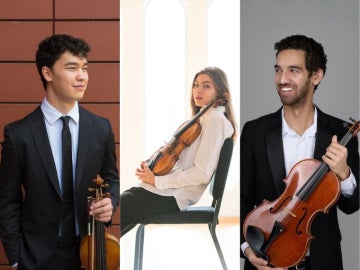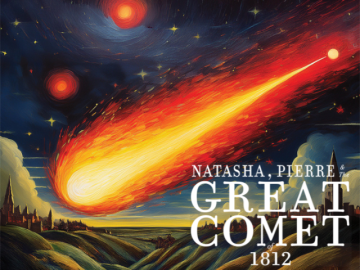Finney on Demand
April 20, 2020
Erich Burnett

Andrew Tripp used a simple two-way speaker to play music and frequency waves in each venue he visited.
Photo credit: Andrew Tripp
A homegrown app allows musicians everywhere to mimic the acoustics of their favorite Oberlin venues.
In the first days of April, as Oberlin’s normally bustling campus was reduced to a lonely whisper, Andrew Tripp began his quest to visit every performance space he could get to. He started in intimate Kulas Recital Hall, then stately Finney Chapel, toting a two-way speaker, a pair of omnidirectional microphones, and a portable recorder wherever he went.
He was capturing information about the way sound reverberates in each room. He hoped to transform that into meaningful data that might be useful to Oberlin musicians who are missing those spaces these days.
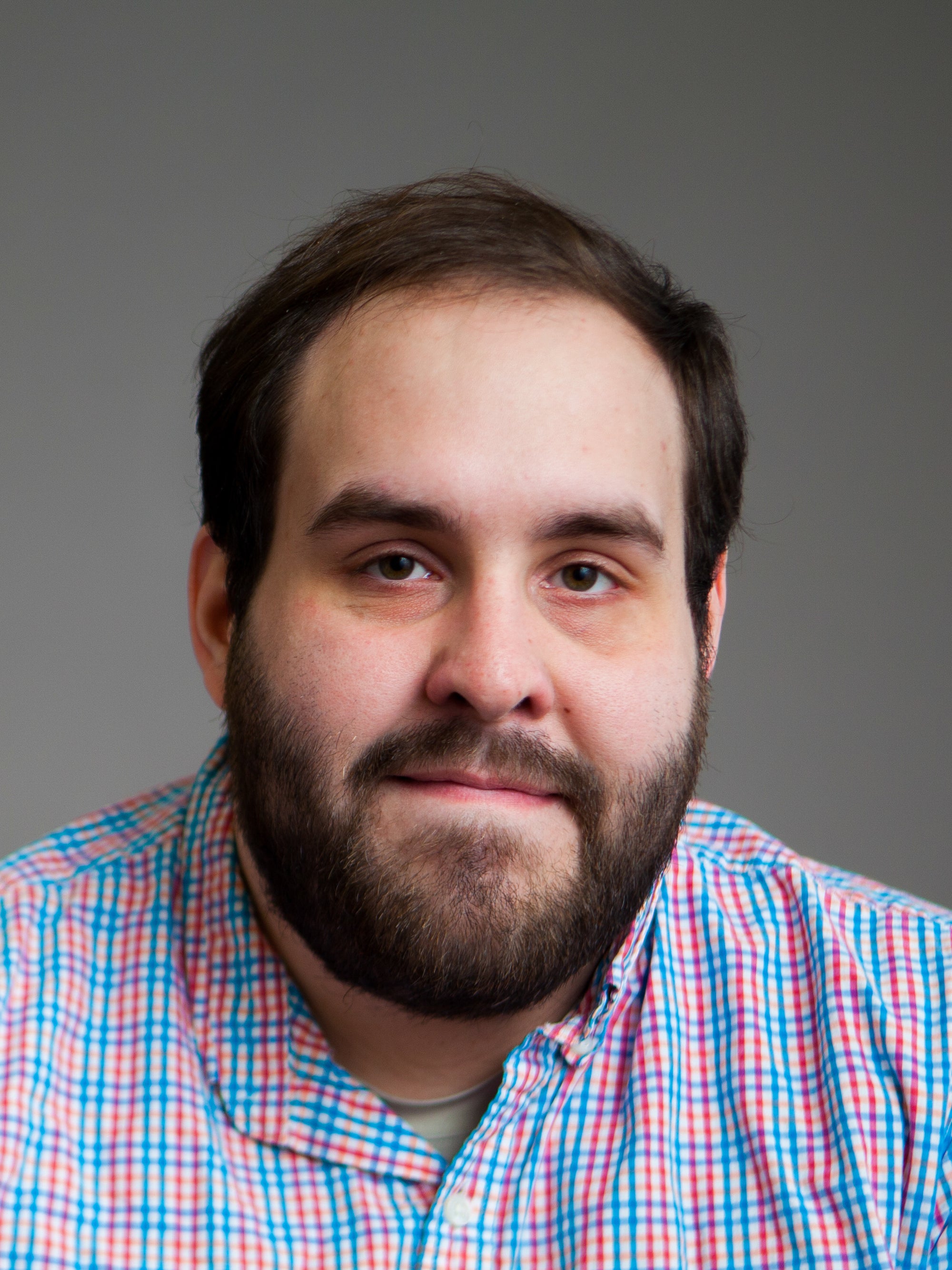
Photo credit: Bryan Rubin ’18
“I had been thinking about this in the back of my head for a few years,” says Tripp, an engineer in the conservatory’s Audio Services Department and codirector of Oberlin's newly developed Recording Arts and Production graduate program. “It seemed to make sense that if a student couldn’t be here, we could bring a little bit of campus to them in some capacity.”
What he hadn’t anticipated was an actual time when students simply couldn’t be here. The nation’s response to the novel coronavirus has changed all that.
As all but a few hundred Oberlin students retreated for their homes and on-campus programming was canceled through the remainder of the spring semester, more than 150 conservatory students saw their junior and senior recitals—pivotal moments in their undergraduate experience—scrubbed from the calendar of events.
Thanks to the work of Tripp and his colleagues in the conservatory’s TIMARA Department (short for Technology in Music and Related Arts), those students now have the option of presenting their music complete with the acoustical attributes of the very venues in which they were scheduled to perform.
“It’s kind of a sonic documentation of our spaces,” Tripp says of his mission, which involved playing and recording music in each space and following that with the playing and recording of a 30-second frequency sweep. “It starts with incredibly low sine waves and sweeps up across the spectrum. All I’m trying to do is capture what the room is doing with that playback."
You can hear the frequency sweep used by Tripp here (please use care in adjusting volume levels; the sweep progresses from inaudible low-pitch waves to extremely high pitches):
The difference between the direct sound properties of the recording and the diffuse sound properties of the venue is called the "impulse response."
“What you end up getting is a pretty good idea of how each space responds to different frequencies. That’s all it is. I was just planning to take the impulse responses and put them out there for anyone who could figure out what to do with them.”
That’s where Tripp’s colleagues in TIMARA took over.
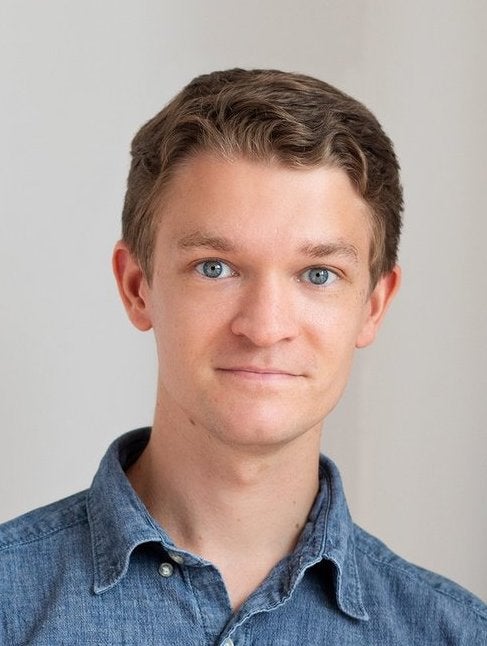
Photo credit: Tanya Rosen-Jones ’97
“The idea is simple, but it has a kind of resonance with the moment we’re all in right now,” says Eli Stine ’14, a former double-degree student in TIMARA and computer science, who returned to campus in fall 2019 as a visiting member of the TIMARA faculty. Since graduating, Stine has worked heavily in software development; his doctoral dissertation focused on audio software.
“Technologies that are able to bring people together at this moment—and together at Oberlin—are particularly awesome,” he says, “and we’d love to keep that momentum of the Oberlin community going.”
Armed with Tripp’s recordings, Stine set about creating an interface that would allow musicians to easily pair their own recorded music with the acoustic properties of their favorite Oberlin locales—even their favorite corner of each locale.
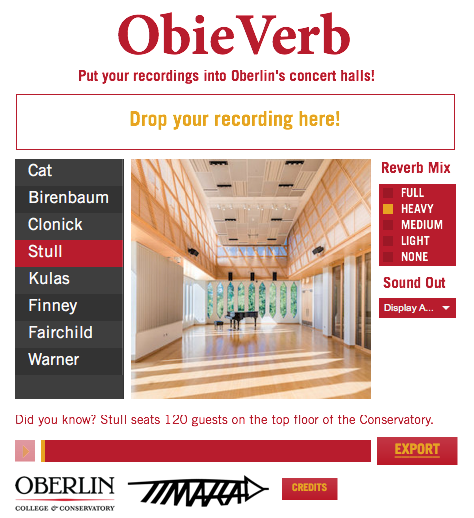
The result of their work is an app for macOS they call ObieVerb (the “Verb” part is short for reverb). It can be accessed, along with an easy-to-follow how-to video, at Virtual Venues with ObieVerb on the Oberlin website.
“Let’s say you’re a trumpet major,” Stine explains. “You record the best recording of yourself you can make with the best mic you can get your hands on. With the app, you can pick your concert hall, then you can pick where you are in the hall. As a trumpet player, maybe you want it to sound like the back of the chapel: Like you’re on the stage and the audience member is in the back of the hall.”
Once you choose the concert hall, you can select the desired amount of reverb ranging from “none” to “full.” Recordings mixed with ObieVerb can then be output through any speaker and exported in a variety of file formats.
“There’s a ton going on under the hood in terms of all the controls you could mess around with, but the mix is the easiest one,” Stine says. “The mix is basically the presence of yourself in the recording; if you were a harpsichord student, rather than a trumpet player, you might want more of the hall in the mix.”
The following music samples illustrate potential effects using ObieVerb:
Violin professor David Bowlin playing Beethoven (original):
The same recording of Bowlin with ObieVerb, set for Fairchild:
An excerpt from a jazz piece written by Chase Jackson '13 (original):
The same jazz excerpt with ObieVerb, set for the Birenbaum:
"This is a great example of combining tools and concepts that we regularly employ for creative work in TIMARA with a practical outcome that is of service to a wide variety of musicians,” says Peter Swendsen, an associate professor of TIMARA and senior associate dean for academic affairs.
“It’s also an elegant intersection of two courses being offered this semester: Eli’s Advanced Electroacoustic Music class [TECH 203] and Andrew’s Advanced Audio Recording [TECH 332]. Eli and Andrew are both incredible practitioners and quickly assembled a tool that is both easy to use and exceptionally high in quality. We are excited for people to try it!”
In recent weeks, Tripp has made the rounds to almost every performance space on campus: Kulas Recital Hall, Finney Chapel, Warner Concert Hall, Stull Recital Hall, Fairchild Chapel, the Cat in the Cream Coffeehouse, Clonick Hall, and the Birenbaum Innovation and Performance Space. All of them are available options in ObieVerb.
“At the very least, I’m hoping it will be useful for TIMARA students as they work through projects now and in the future,” Tripp says. “But I can imagine it potentially being useful for someone who is recording their junior or senior recital away from campus if they want to add a little bit of Oberlin flavor to it.”
Tripp has also gotten input from his ever-inventive students.
“The class gave me some great suggestions for other venues to record,” he says. “They want me to do the old Hales swimming pool. They want me to do the racquetball courts.”
You may also like…
Amy Lee Joins Oberlin Conservatory Faculty as Associate Professor of Violin
The renowned violinist and associate concertmaster of the Cleveland Orchestra brings extensive teaching and performing experience to Oberlin
Oberlin Students Selected for Prestigious New York String Orchestra Seminar
Directed by Oberlin artist in residence Jaime Laredo, intensive 10-day experience culminates in performances at famed Carnegie Hall.
"The Great Comet" Starts Something New
Oberlin Music Theater's inaugural production is a story of beginnings, which is a fitting theme for the first main stage performance of the Conservatory's newest program.
